Takada Seiyujo’s Camellia Oil from Izu Oshima Camellias
Feb 07,2019
Takada Seiyujo’s Camellia Oil from Izu Oshima Camellias
Feb 07,2019
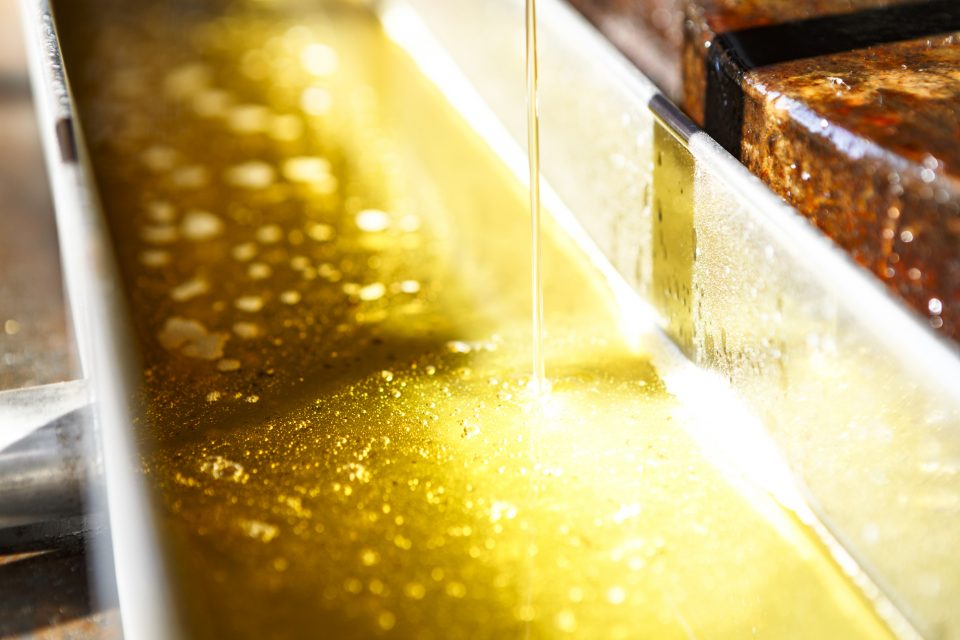

Many people likely think of camellia oil only in the context of haircare or skincare. This is probably because people mostly see camellia oil in the cosmetics aisles. On Izu Ohshima, however, camellia oil is not only used as a cosmetic; it plays a large role in cooking as well. Even today, when countless varieties of oil from around the globe are readily available, traditional Japanese camellia oil remains deeply rooted in daily life. It’s a relationship built on a long history, rich in depth and flavor.
Our image of camellia oil as a beauty oil transformed abruptly in mid-October, when the camellia flowers began to bloom. The change happened during a visit to Takada Seiyujo, a camellia oil producer in Motomachi, Izu Ohshima. While talking on and off with Takada Yoshito, the fourth-generation owner, people arrived one after another, carrying large paper bags and boxes. Takada went over the contents of the bags and boxes with them, weighed them, and had a brief conversation, before the people left smiling.
What in the world was going on at Takada Seiyujo?
“If people bring in harvested camellia seeds after first drying them out thoroughly, we exchange camellia oil or cash for them,” says Takada. “This is a traditional form of barter on Izu Ohshima. The reason for this is drying and sorting the camellia seeds after they have been harvested and then extracting the oil takes a lot of time and effort.”
A woman who had packed a large paper bag full of camellia seeds and carried it in with her sister took cash in exchange. “Gathering the seeds is a hassle, but it’s made more pleasant by bringing them here and getting some pocket money,” say the two sisters with big grins.
A woman brought in a huge amount of camellia seeds by car. “I always exchange them for camellia oil. I use it in stir-fries and tempura and as a salad dressing. I use other kinds of oils too, but we can’t do without camellia oil in our house.”
A man who comes every year says: “I always give the oil as a gift to my son’s family. Camellia oil is delicious, but it’s expensive to buy. So they’re very happy, and that makes me happy too. Harvesting the seeds and drying them is definitely worth the effort.”

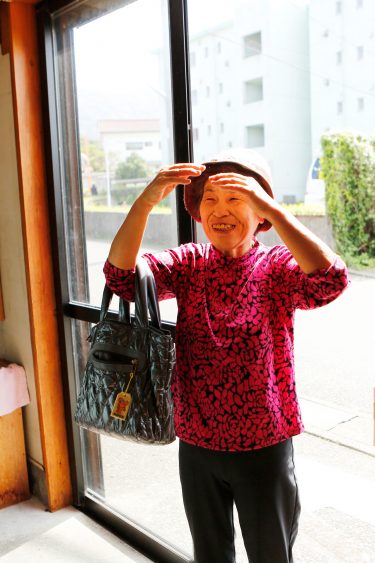
A woman who carried in a large bag with her sister was all smiles after exchanging camellia seeds for cash. For her, camellia seeds are a source of pocket money.
After learning that camellia oil is delicious, our eyes turned to the joy of gathering camellia seeds that the islanders look forward to so much.
If you walk around Izu Ohshima in the fall, you will see camellia seeds in baskets waiting to be sorted or spread out neatly on sheets in people’s yards waiting to dry.
“The drying and sorting process reveals a person’s character. Those who are meticulous about the work have a strong sense of involvement in making camellia oil. Occasionally, however, there are people who don’t dry the seeds out enough or don’t sort them. Some do a better job after being called out, but others keep bringing in moldy seeds no matter how many times they’re told. That’s the one thing we simply can’t let slide.”
Takada laughs heartily despite his stern look. Behind that expression is the pride of an artisan. Camellia oil is not merely a product; it belongs to everyone who brings in seeds. The responsibility to maintain the oil’s quality, however, rests solely on his shoulders.

Takada Yoshito, the fourth-generation owner of Takada Seiyujo. “I’ve got nothing to hide in my workplace. People are welcome to look in anytime. However, I’m an artisan who makes oil, so I’m not too good at interacting with customers.” Despite his words to the contrary, when he has time, he’ll gladly share stories.
Takada Seiyujo was founded in 1929, and Takada Yoshito is the fourth-generation owner. Since its founding, the company has produced natural camellia oil using wild camellia found on Izu Ohshima.
Takada Seiyujo uses a traditional tamajime [stone-milled] press to slowly extract the oil, which takes time and effort. First, the camellia seeds are dried and each one is checked individually. The islanders sort the seeds before bringing them in, but the final selection process is done by Takada and his brother-in-law, Fukui Noriaki.
“We probably spend about 100 days a year selecting seeds.”
They both laugh, but the seeds are crucial to the quality of the oil. Since the oil is 100 percent natural, seed selection is a critical process that they can’t skimp on. Each seed is carefully hand-selected by feeling its texture and inspecting it visually.
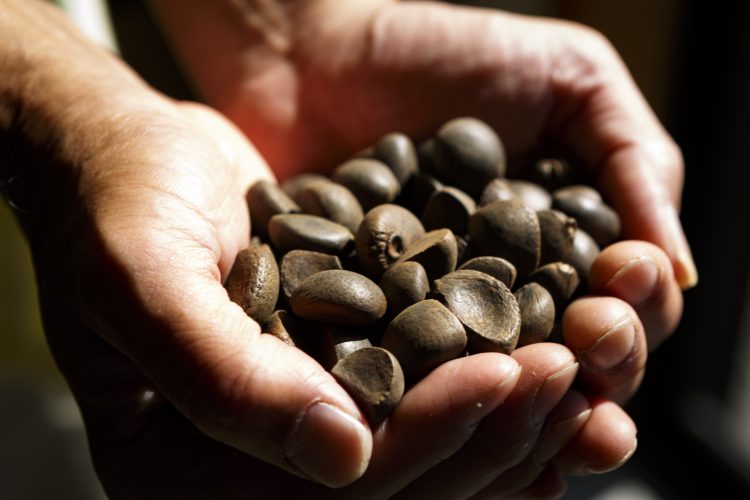
Selecting the camellia seeds is a crucial process that impacts the oil’s quality. Takada and Fukui work silently but their hands never stop moving.
The carefully sorted and selected seeds are dried even further and then move on to the oil extraction process.
The seeds, shell and all, are first crushed into fine bits with a grinder. Inside the hard, dark shell is a vibrant green. Bringing it close to your nose, you smell a young fragrance that has no conceivable link to oil at all.
“Our camellia oil contains saponins because we grind the seeds with their shells on. Saponins are antioxidant components, found also in soybeans, that help protect the body from oxidative stress. The shells of camellia seeds contain lots of saponins, so grinding the seeds whole is the best approach. They lend a slight bitterness, which is part of the overall camellia flavor profile.”
The crushed seeds are placed in a wooden barrel and taken to the steaming station.
Once the seeds begin to be steamed under high pressure, a pleasant aroma, like that of steamed chestnuts, spreads throughout the workplace.
“We steam them for about five minutes or so. When their bulk is reduced and they are thoroughly moist, it’s easier to extract the oil.”
Fukui, who oversees this process, inserts a wooden stick into the barrel, pats down the seeds a little, and then moves the freshly steamed barrel to the next work station. No timers or clocks are used. Fukui explains: “I’m not stirring the seeds with the wooden stick. What I’m doing is judging how the steaming is progressing by how the stick feels when I insert it.” Though it may seem like a simple five-minute steaming process, it requires the hands and feel of an artisan.

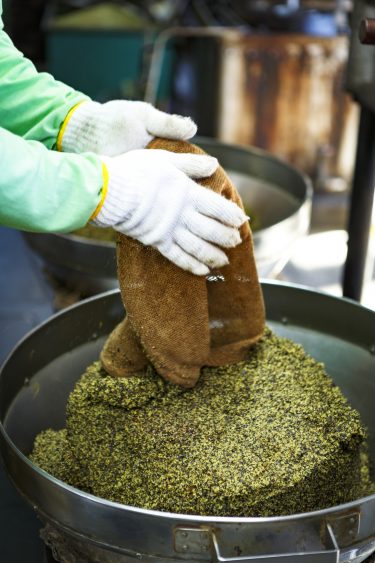
The crushed camellia seeds are steamed for about five minutes. This minimal heating prepares them for easier oil extraction.
Now that the camellia seeds are ready, it’s time to finally extract the oil.
The steamed seeds are immediately packed into thick, sturdy cloth baskets while still warm and loaded into tamajime presses, which extract the oil. The presses have been in use since the Meiji period (1868 to 1912) and are meticulously polished. Despite their simple appearance — a sturdy cast-iron frame with a large granite stone — they operate on a hydraulic system. The hydraulic pressure raises the lower platform, pressing the seeds against the fixed upper stone and squeezing out the oil. The hydraulic pressure reaches an impressive 10 tons. As the pressure slowly builds, golden oil begins to flow out, resembling honey.
“Yes, it does look like honey. Other people say it looks like melted butter. The very first extracted oil has a sweetness to it. Over time, the saponins contained in the bitter shell start to be extracted as well. The last part of the extraction has a bit of a bitter taste to it.”
The flavor inconsistencies are naturally evened out before the product is bottled. But by minimizing the heating to make the most of the natural flavors, even the presence of saponins, which are invisible to the eye, can be detected.
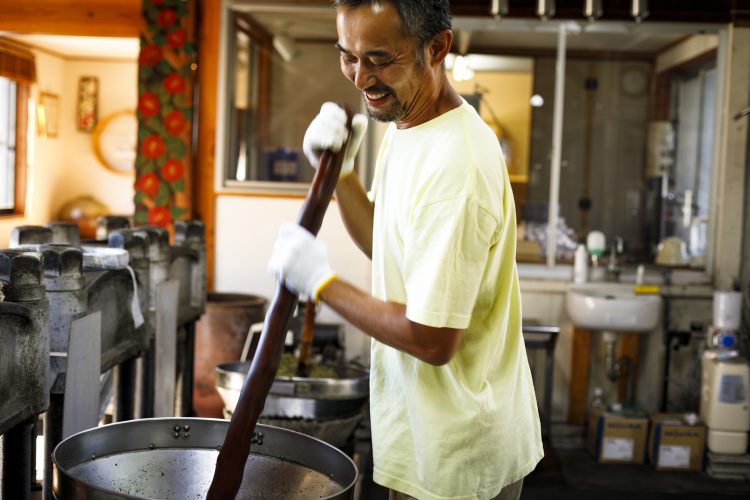
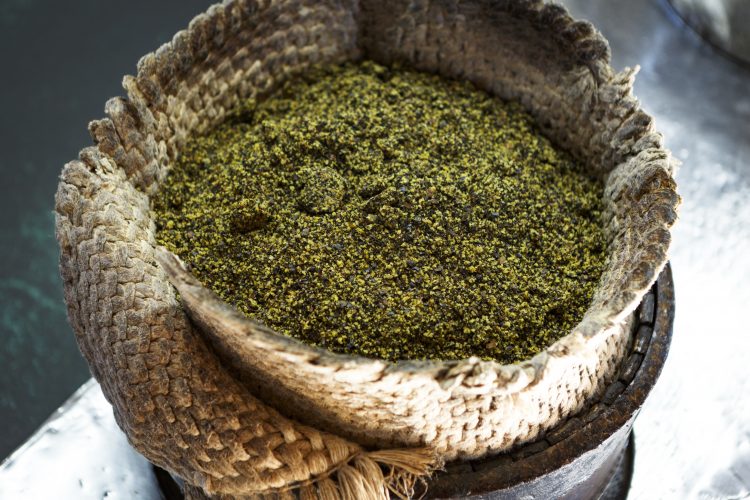
Steamed camellia seeds are loaded into a tamajime press. A large funnel and Takada’s favorite stick, made from a camellia branch, are used to pack the seeds into the extraction container without any gaps. Though the work requires considerable physical strength, they carry out the process in silence, with no wasted movements. The tools after use and the floor after the process are spotless, with no traces of dirt.
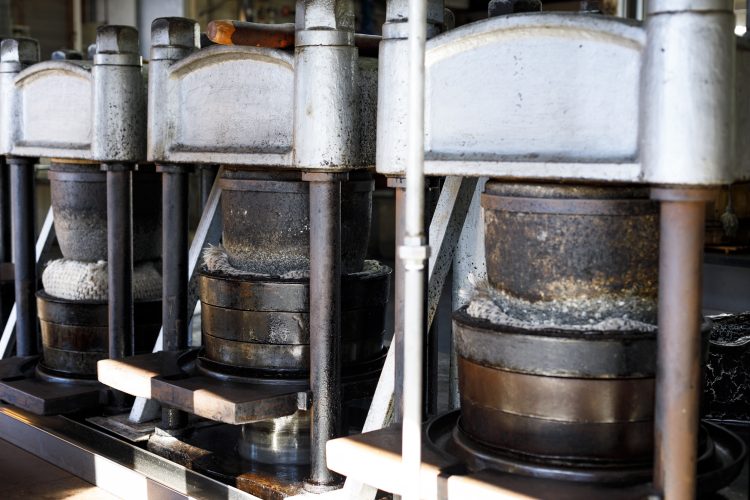
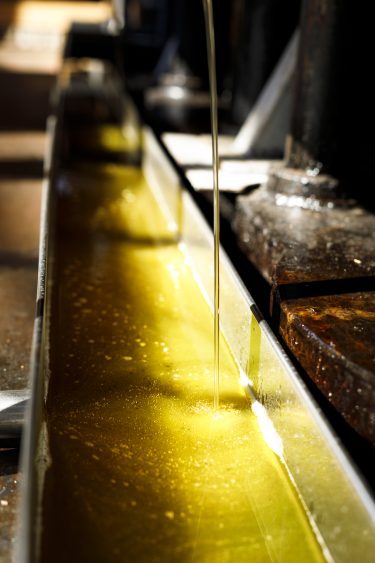
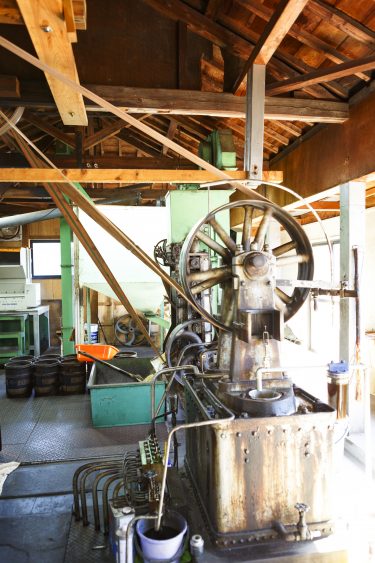
Five tamajime presses are set up in a line. The upward pressure slowly extracts the oil, which is then collected. A belt-driven variable-speed motor in the center of the workplace applies the pressure to the presses. The motor automatically regulates the applied pressure.
The pressed camellia oil is left overnight to allow any impurities to settle out. It is then passed through several types of filters to filter the oil without losing its flavor. A quick taste of the finished oil reveals a rich, nutty flavor with a subtle sweetness and a strong presence. The oil’s moderate viscosity makes it ideal for dressings and marinades, as it adheres well to ingredients.
Camellia oil is said to be healthy. It contains 85 percent oleic acid, resists oxidation, and is believed to help reduce bad cholesterol in the blood. Compared to olive oil, which is also known for its resistance to oxidation and contains approximately 76 percent oleic acid, camellia oil stands out. Oleic acid is similar in composition to human sebum, making it easily absorbed by the skin and providing comfortable moisturization. This is why the oil has been used for beauty purposes for centuries. Applying camellia oil to skin or hair dried out by sea breezes leaves them soft and moisturized. Given Izu Ohshima’s location surrounded by the sea and its limited resources, it’s no surprise that camellia oil has played a vital role in sustaining the health of the islanders.
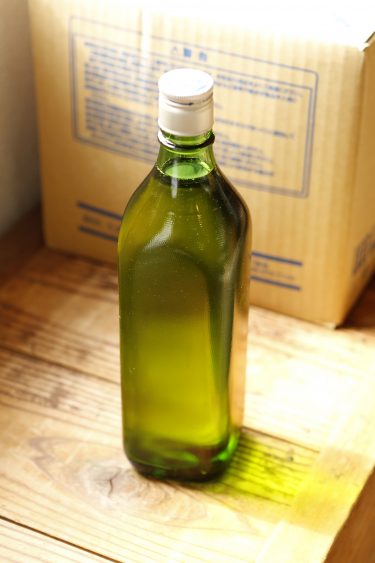
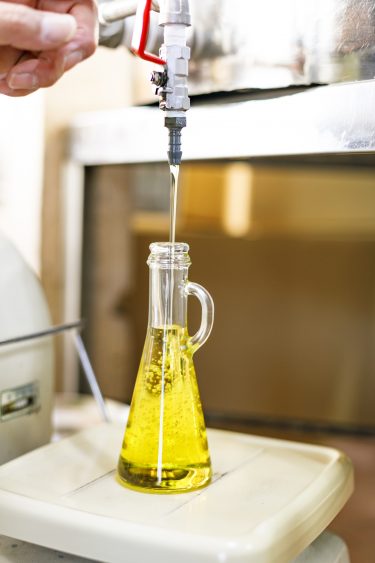
People who exchange camellia seeds for camellia oil bring their own bottles to get refilled with oil. It’s an eco-friendly system that doesn’t waste resources.
Today, there are many methods for producing oil. Methods that heat the ingredients to high temperatures and use centrifugal separators to remove colors and odors are not uncommon among producers that prioritize efficiency and supply stability. The problem is that these methods strip the oil of its natural flavor. Moreover, made-in-China camellia oil, which uses sasanqua camellia seeds, has a completely different aroma and taste from the oil of wild camellia plants.
“Wild camellia plants are a native Japanese species with higher sugar content than other varieties, resulting in a sweeter, better-tasting oil. Wild camellia plants have grown on Izu Ohshima for centuries. The volcanic soil drains well, and the island receives ample rainfall. These conditions likely contribute to the quality of the camellia seeds. However, it takes a whole 30 years for a wild camellia plant to produce good seeds after planting. Moreover, they only produce seeds every second year. We also procure seeds from camellia farmers on the island, but the harvest yields are unreliable, with some years bringing in 40 tons and others only four tons.”
Since the amount of the primary ingredient cannot be guaranteed, camellia oil cannot be mass produced on the island, which results in relatively high prices. But Takada is firm in his intention to stick with the current method.
“My aim is not to stabilize the supply or use high-efficiency methods to produce camellia oil. And I can’t imagine procuring camellia seeds from off the island. That’s because I believe it’s important for us to continue what has been passed down to us without changing or modifying it.” Despite this, Takada still has big dreams.
“Nothing goes to waste with camellia plants. We produce almost no waste at all. Camellia oil is useful for cosmetics and cooking. The strained lees can be used as fertilizer, fuel, or glazing pottery. The camellia plants need pruning to produce good seeds, but the pruned branches make excellent charcoal, which is useful for cooking and camping. The plants serve as windbreaks around the farm. There’s no waste anywhere. Living in a world where camellias are circulated naturally without waste is very appealing. I’d like more people, whether they live on the island or not, to know about this. For example, at a campsite, you could enjoy cooking with camellia oil using camellia charcoal. The oil goes well with salt produced on Ohshima, maybe because they are both produced locally, which is something I want people to experience. Then, at night, you could sip your drink while listening to the crackling sound of the camellia charcoal and the soft glow of the flames. It would be amazing to offer such an experience on Izu Ohshima.”
Fueling this passionate speech is Takada’s dream and his love for Izu Ohshima.
“From autumn to winter, in addition to the oil extraction work, there’s a crush of people bringing in camellia seeds, so this season is really intense. Look at me now, I’m baked,” he says, but of course he’s joking. His efficient movements as he carries out his tasks, and his pristine workshop, foster an atmosphere of focused determination.
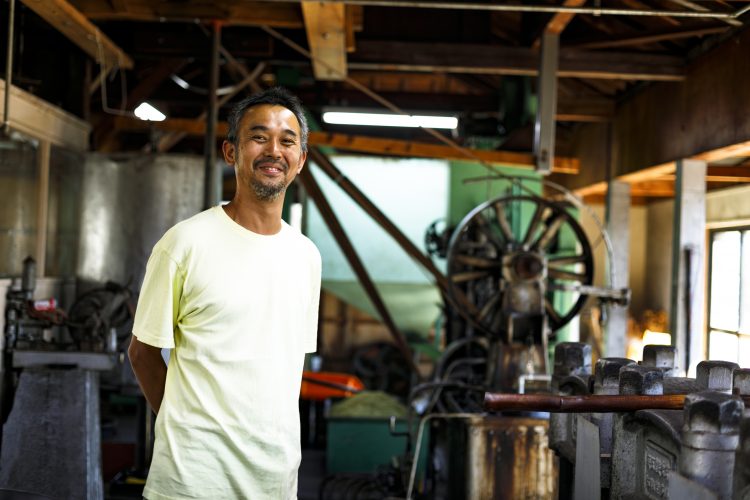
“I really like Izu Ohshima.” This love is at the center of everything Takada does. In recent years, the island has seen an increase in newcomers and returnees from the mainland. “Young people also collect and bring in camellia seeds. Even if they don’t dry or sort the seeds very well the first year, after a couple of years, they bring in beautiful seeds,” he says happily.
Behind the building, on a porch, is Takada Hachiro, Yoshito’s grandfather and the second-generation owner, sitting in the sun.
“He might look like he’s asleep, but he’s keeping an eye on our work. He’s cheering us on.”
In 2019, Takada Seiyujo celebrated its 90th anniversary.
The circulation of camellia, a scene that has been repeated every autumn and winter on Izu Ohshima for generations, remains unchanged despite the passage of time. In the years to come, camellia seeds and camellia oil will continue to connect people and bring richness to their lives.
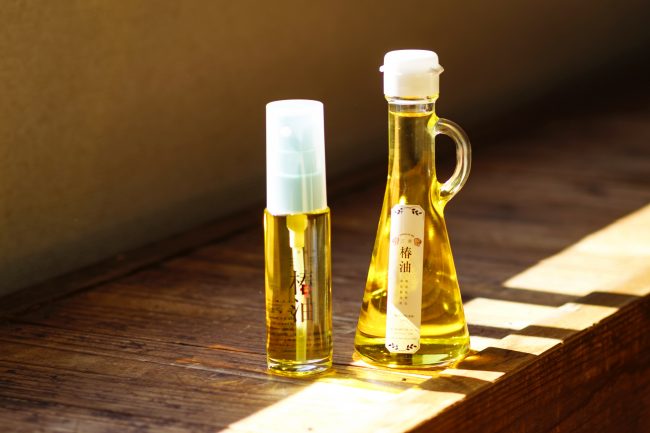
*Online sales are available from the website.
●Getting to Izu Ohshima
Getting to Izu Ohshima takes an hour and 45 minutes by high-speed jet ferry or six hours by overnight ferry from Tokyo’s Takeshiba Sanbashi Pier. There are also ferry services from Yokohama Port and Kurihama Port in Kanagawa and Atami Port and Ito Port in Shizuoka.
Contact Tokai Kisen at 03-5472-9999 or 0570-005710
URL:https://www.tokaikisen.co.jp/
The annual Izu Ohshima Camellia Festival is underway from January 27 to March 24, 2019.
URL:https://www.tokaikisen.co.jp/tsubaki_festival/